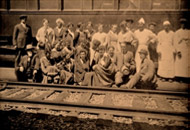City Directories and History: The Gregg-Wallace Farm Tenant House represents a broad cultural pattern that existed when most African Americans in the rural south lived in tenant houses from 1865 until World War II. The house also represents a particular aspect of the tenant house that was found in Mars Bluff where white landowners exercised control for a longer period through the use of a cartel that trapped African Americans in the tenant houses and in wage labor. The construction of the house is also significant because it preserves tangible evidence of the evolution of a typical Mars Bluff vernacular tenant house. When J. Eli Gregg moved to Mars Bluff in 1836, he brought African-American slaves to plant and harvest cotton, but first they hewed timbers and built the houses in which they would live. After emancipation, African Americans wanted to buy small plots of land so that they could build their own homes. Owning their own homes and gardens would have made them free to offer themselves in a free labor market. But Gregg and other large landowners at Mars Bluff wanted to keep a supply of cheap labor, so they made secret agreements not to sell land to African
The Yorkville Enquirer reported on Oct. 21, 1891 – “An engine boiler belonging to Eli Gregg and son, at Mars Bluff, six miles from Florence, exploded last Wednesday. One man was killed and two were terribly scalded. A gin house was wrecked.”
Americans and not to allow them to move to another plantation without the consent of the previous landowner. Thus African Americans were kept dependent on the land owners for their houses, their food, and their jobs. The only concession that Gregg made was to add rooms to the old slave houses and to move some of the houses from the street to scattered locations on the farm. About 1890, with tenants still working the farm, J. Eli Gregg’s son Walter built the tenant house at 310 Price Road. Then in about 1920, when Walter Gregg’s son-in-law, Wilds Wallace, was owner of the house, one of his best workers, Otis Waiters, had a rapidly growing family and wanted a larger house, so Wallace added a bedroom on the front of the house. When mechanization reduced the need for farm labor and two world wars presented economic opportunities elsewhere, many African Americans left Mars Bluff and many tenant houses were abandoned. Still, for lack of other housing, people were obliged to continue living in tenant houses even when they were working in local service jobs or in industry. Ms. Mattie Smalls Gregg lived in the Price Road tenant house from 1959 until her death in 1989. Ten years later when her son moved from the house, he left behind a collection of tenant-house artifacts. Today, the artifacts are being preserved in the unoccupied house. (Courtesy of the SC Dept. of Archives and History)
Stay Connected
Explore history, houses, and stories across S.C. Your membership provides you with updates on regional topics, information on historic research, preservation, and monthly feature articles. But remember R&R wants to hear from you and assist in preserving your own family genealogy and memorabilia.
Visit the Southern Queries – Forum to receive assistance in answering questions, discuss genealogy, and enjoy exploring preservation topics with other members. Also listed are several history and genealogical researchers for hire.
User comments welcome — post at the bottom of this page.
Please enjoy this structure and all those listed in Roots and Recall. But remember each is private property. So view them from a distance or from a public area such as the sidewalk or public road.
Do you have information to share and preserve? Family, school, church, or other older photos and stories are welcome. Send them digitally through the “Share Your Story” link, so they too might be posted on Roots and Recall.
Thanks!

